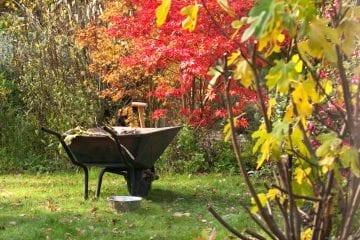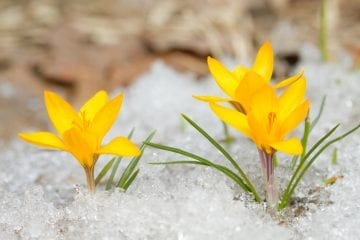“I’m so glad I live in a world where there are Octobers.”
L.M. Montgomery
You are watching: Winterizing Your Garden: Fall Steps to Successfully Weather Winter
For many of us, the word ‘fall’ is synonymous with cinnamon, pumpkin pie, and mulled apple cider. It speaks of cool crisp evenings, family Thanksgiving gatherings, pumpkin carving, cozy nights spent curled up in front of a fire, and anticipation of the first flurries. Each year, our eyes are treated to the glorious sights of the season and it’s as if we’re experiencing the beauty and majesty of the world’s show-stopping colour displays for the first time.
 Short as the season is, there is so much to be done! There are chores to start and finish, the closing up of cottages, the de-cluttering of indoor spaces, and steps needed to prepare your outdoor living space for winter. Living in Canada offers the sure promise of winter and within a month or two, snow will be flying and the frost will have settled in. Before this happens, you will want to make sure your gardens are ready to face the cold months ahead!
Short as the season is, there is so much to be done! There are chores to start and finish, the closing up of cottages, the de-cluttering of indoor spaces, and steps needed to prepare your outdoor living space for winter. Living in Canada offers the sure promise of winter and within a month or two, snow will be flying and the frost will have settled in. Before this happens, you will want to make sure your gardens are ready to face the cold months ahead!
Winterizing gardens and ponds can look different from home to home, so it is good to examine your gardens and winterize according to its particular needs. It can depend on factors such as your location, the age of your garden, and how much wind certain plants will receive throughout the season. Well-established plants may not need as much attention and protection from the elements as newly planted or less hardy varieties. As a general rule, prevention is the best medicine when preparing your pond and garden for winter!
Bring in Any Tropicals/Houseplants Indoors
If you have any potted tropical plants or annuals that you want to keep around for another summer, be sure to bring them indoors. Tropicals cannot withstand our deep frost and cold temperatures, and potted plants’ root systems will not be well protected in plastic or fibreglass pots.
Read more : 10-Steps to Repair Wicker Furniture
Take the time to clean up your plants, removing dead leaves, dead blooms, and re-potting if your plants are bursting at the seams. Gradually adjust your plants to less sunny locations in your home, giving them time to transition to changed amounts of sunlight and moisture.
Before bringing them indoors, be sure to check for bugs! You don’t want to be bringing any bugs into your home that could damage your indoor plants. Try washing your plants and spraying them with a gentle insect spray, such as “House Plant & Indoor Garden Insect Spray” which you can find at our nursery!
Plant New Shrubs and Divide Perennials
Take the time to walk through your gardens and decide space that can be filled with new shrubs or perennials. Fall is a terrific time to do this because the colours, textures, and knowledge on what bloomed when, how long it lasted, and when you would want colours to help balance your garden out will be fresh in your memory. You can also take the time to divide large perennials, finding space for them in other areas of your garden and balancing plant sizes.
Give the Gardens a Thorough Weeding
Make sure your gardens are well weeded, and get rid of any invasive weed or plants that may have made their way into the garden. You want to have your garden as healthy as possible before heading into winter.
Deadhead/Cut Back Perennials
Take the time to clean up around your plants, removing any dead leaves or spent stalks. This can help prevent disease and it will also help give your garden a tidy look before heading into the winter season.
Water Your Evergreens
Give your evergreens a thorough watering before final freeze up. The moist ground will freeze and be a better insulator throughout the winter than dry soil.
Plant Your Fall Bulbs
Read more : 27 Best Ways to Fill The Bottom of a Large Planter
Fall is the time to plant your spring blooming bulbs! For more tips on planning and planting your fall bulbs, check out our blog article!
Bundle Up New Shrubs
Use burlap to wrap up newly planted or less-than-hardy trees and shrubs. It is important to protect the young plants from the bitter winds and snow, and a layer or two of burlap will help them weather the season until they’re better established. Spray any broadleaved evergreens or recently planted evergreens with an anti-desiccant such as Wilt-Pruf or wrap them with a double layer of burlap to prevent the foliage from drying out! Remember to wrap your Japanese Maple trees as well.
Wrapping tree trunks with burlap or spiral tree guards is also a good way to keep any critters away!
Put Down Mulch
Put down a thick layer of mulch in your garden beds, particularly around newly planted shrubs and perennials. You can also hill/mound particularly tender plants, such as roses and newly planted perennials and woody shrubs, with 12” of triple mix and mulch. This will help insulate the plants and protect the roots against continually freezing and thawing cycles.
Water Features
Take the time to cover your pond with a net to stop leaves from landing on the water. Switch to a cold-water bacteria as the water temperature drops to mimic nature’s cleaning agents and decrease the sludge build up come spring.
If you have fish in your pond, stop feeding them when the water temperature drops below 10C, as their digestive systems slow during the winter and any food they take in out of habit may sit in their bellies and cause harm. Maintain a 6” to 8” opening in the surface for gas exchange and a source of oxygen through winter, and if you’re not using a pond de-icer, move your pump near the surface and keep it running all winter, as the movement of the surface water will help prevent freeze up.
Find all the tools and supplies you need to prepare your garden and pond for winter at Royal City Nursery! We are open all year round, and have the knowledge and supplies you need to successfully winterize your outdoor living space! Stop in to see us today!
Source: https://gardencourte.com
Categories: Outdoor

